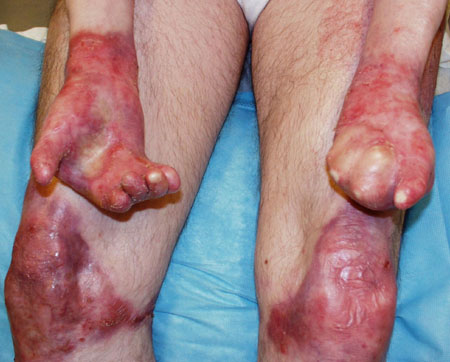Complications
Typical feature among patients with severe junctional epidermolysis bullosa (EB).
May prove fatal during early infancy.[65]
Severe multi-factorial anaemia is common among more severe EB sub-types, most notably severe junctional EB, and severe recessive dystrophic EB.[39]
Results from chronic loss of iron and other nutrients from open wounds, as well as poor absorption of nutrients through the intestinal tract.
Only modestly improved by oral or infusible iron supplementation.
Moderate to severe growth retardation is typical among patients with severe junctional EB, generalised severe and severe recessive dystrophic EB.[39]
The result of poor nutritional intake and absorption.
Only partially offset by aggressive nutritional supplementation, including gastrostomy feedings.
Because some infants have difficulty in sucking, due to painful oral erosions and blisters, modified feeding nipples, such as those used for infants with cleft palates, may be beneficial.
Nearly every patient with severe recessive dystrophic EB (RDEB), and smaller numbers of patients with other sub-types of RDEB, dominant dystrophic EB, and junctional EB, develop at least partial webbing and mitten deformities.[40][Figure caption and citation for the preceding image starts]: Hand deformities, extensive scarring of wrists and legs in a child with recessive dystrophic EB, generalised severe (RDEB-gen sev)From the collection of J.D. Fine, MD [Citation ends].
Initially arise on the feet but eventually may also severely involve the hands, causing marked functional impairment.
Surgical de-gloving of hand (mitten) deformities may at least temporarily improve functionality.[40]
However, surgery may have to be repeated sequentially, in order to prevent recurrence of further progression of webbing of the digits.
Foot webbing is not usually treated.
SCC arises in the skin of at least 90% of all severe recessive dystrophic EB (RDEB) patients by about 50 years of age.[85]
Lower frequencies occur in other RDEB sub-types and in junctional EB (JEB).
The occurrence of multiple primary SCCs is the typical pattern seen in patients with generalised RDEB.
Although histologically well-differentiated, these tumours act very aggressively.
Wounds that are unusual in their duration and lack of improvement, or the presence of nodules in children or adults with RDEB or JEB, merit full-thickness skin biopsy to exclude SCC.
If SCC is confirmed, then wide full-thickness excision is mandated.[62]
All patients with junctional EB develop enamel hypoplasia, the result of laminin-332 defects within the teeth.[41]
Severe caries then occur, with premature loss of teeth.
Patients with severe recessive dystrophic EB develop severe blistering and scarring within the oral cavity, including the tongue.
Ankyloglossia and microstomia are common complications.[60]
Severe caries may secondarily occur in these latter patients as a result of prolonged retention of food particles within the oral cavity.
Aggressive dental intervention, initiated within early childhood, may partially offset the severity of some of these complications.
More patients severely affected by EB commonly experience moderate to severe depression as a result of their condition.[89]
Develops as early as within the first year of life and initially presents as intermittent dysphagia to solid foods.
Nearly all patients with severe recessive dystrophic EB and most patients with some other severe EB sub-types will experience this complication.[64]
It may be treated, when symptomatic, with oesophageal dilation.
Untreated, it impairs intake of nutrients, particularly solid foods.
Only infrequently associated with gastro-oesophageal reflux disease.[42][64]
Although the actual frequency of CRF in EB is unknown, the lifetime cumulative risk of death from CRF in severe recessive dystrophic EB and generalised severe EB is about 12%.[84][65]
CRF most commonly develops as a result of glomerulonephritis (presumably post-streptococcal) or renal amyloidosis.
Renal replacement therapy and immunosuppression with rituximab has been used in some patients.
Painful corneal erosions occur in a subset of patients with junctional EB and recessive dystrophic EB.
The frequency of scarring is much lower.[86]
Seen in association with a rare sub-type of EB simplex (EBS with muscular dystrophy [EBS-MD]).
May be mild or severe and may be of late onset.
A few patients with severe recessive dystrophic EB are at risk of developing dilated cardiomyopathy.[87][88]
Although the cause is still controversial, this may be the result of carnitine deficiency.
Another contributing factor appears to be chronic renal failure. This complication may be fatal.
Severe cardiomyopathy has been seen in several patients with a rare EBS sub-type associated with KLHL24 mutations.[43][44]
A few children with junctional EB have congenital pyloric atresia.[90]
This may be surgically repaired.
A rare complication of recessive dystrophic EB, especially in those with severe disease.
Although not confirmed, it probably results from chronic streptococcal infections of the skin.
This condition may lead to chronic renal failure.[84]
A known complication of severe recessive dystrophic EB and may lead to chronic renal failure.[84]
Painful urethral strictures may arise in the more severe EB sub-types as the result of repeated blistering around the urethral meatus.[91]
Most can be managed with repeated dilations, but rare patients have developed worsening strictures as a result of such surgical manipulations. Chronic urethral strictures, if severe, should be treated, because their presence has been attributed to the development of hydroureter, hydronephrosis, and subsequently chronic renal impairment in some patients.
Osteoporosis is known to occur in patients with both generalised sub-types of recessive dystrophic EB. It is partially promoted by chronic immobilisation or reduced physical activity and may be associated with pathological fractures and bone pain.
Use of this content is subject to our disclaimer